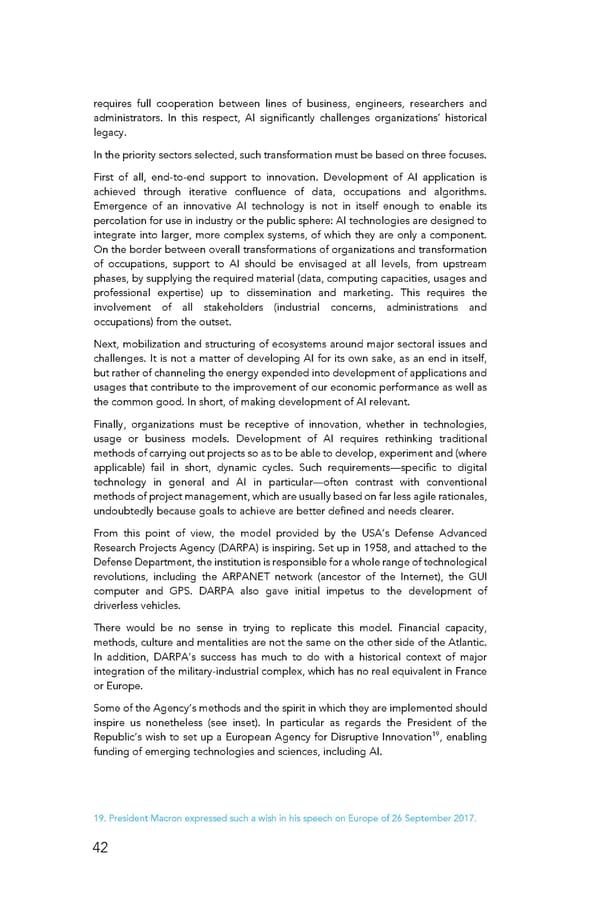requires full cooperation between lines of business, engineers, researchers and administrators. In this respect, AI significantly challenges organizations’ historical legacy. In the priority sectors selected, such transformation must be based on three focuses. First of all, end-to-end support to innovation. Development of AI application is achieved through iterative confluence of data, occupations and algorithms. Emergence of an innovative AI technology is not in itself enough to enable its percolation for use in industry or the public sphere: AI technologies are designed to integrate into larger, more complex systems, of which they are only a component. On the border between overall transformations of organizations and transformation of occupations, support to AI should be envisaged at all levels, from upstream phases, by supplying the required material (data, computing capacities, usages and professional expertise) up to dissemination and marketing. This requires the involvement of all stakeholders (industrial concerns, administrations and occupations) from the outset. Next, mobilization and structuring of ecosystems around major sectoral issues and challenges. It is not a matter of developing AI for its own sake, as an end in itself, but rather of channeling the energy expended into development of applications and usages that contribute to the improvement of our economic performance as well as the common good. In short, of making development of AI relevant. Finally, organizations must be receptive of innovation, whether in technologies, usage or business models. Development of AI requires rethinking traditional methods of carrying out projects so as to be able to develop, experiment and (where applicable) fail in short, dynamic cycles. Such requirements—specific to digital technology in general and AI in particular—often contrast with conventional methods of project management, which are usually based on far less agile rationales, undoubtedly because goals to achieve are better defined and needs clearer. From this point of view, the model provided by the USA’s Defense Advanced Research Projects Agency (DARPA) is inspiring. Set up in 1958, and attached to the Defense Department, the institution is responsible for a whole range of technological revolutions, including the ARPANET network (ancestor of the Internet), the GUI computer and GPS. DARPA also gave initial impetus to the development of driverless vehicles. There would be no sense in trying to replicate this model. Financial capacity, methods, culture and mentalities are not the same on the other side of the Atlantic. In addition, DARPA’s success has much to do with a historical context of major integration of the military-industrial complex, which has no real equivalent in France or Europe. Some of the Agency’s methods and the spirit in which they are implemented should inspire us nonetheless (see inset). In particular as regards the President of the 19 Republic’s wish to set up a European Agency for Disruptive Innovation , enabling funding of emerging technologies and sciences, including AI. 19. President Macron expressed such a wish in his speech on Europe of 26 September 2017. 42
 For a Meaningful AI - Report Page 42 Page 44
For a Meaningful AI - Report Page 42 Page 44